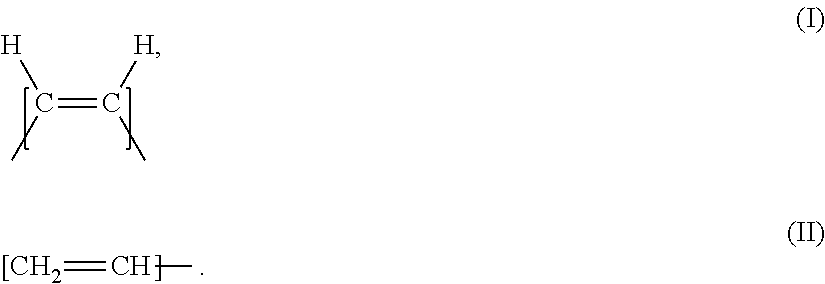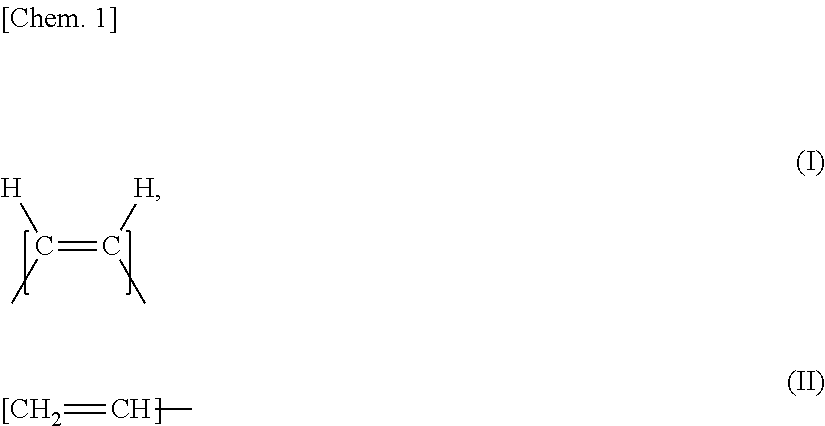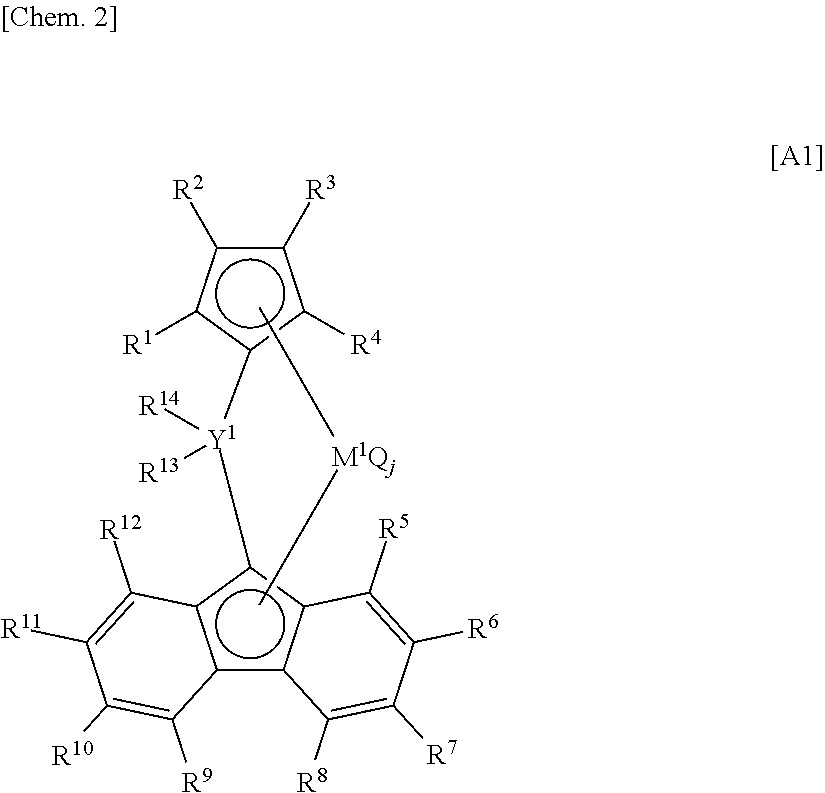Ethylene/alpha-olefin/non-conjugated polyene copolymer, and production process and use thereof
- Summary
- Abstract
- Description
- Claims
- Application Information
AI Technical Summary
Benefits of technology
Problems solved by technology
Method used
Image
Examples
examples
[0543]Although the present invention will be described more specifically based on the following Examples, the invention is not limited thereto.
[0544]In the following Examples and Comparative examples, ethylene (A), propylene as an α-olefin (B), VNB as a non-conjugated polyene (C), ENE as a non-conjugated polyene (D) are appropriately used to produce a copolymer to demonstrate advantageous effects of the invention, but the α-olefin (B), the non-conjugated polyene (C), and the non-conjugated polyene (D) are not at all limited to these compounds.
[0545]Evaluation methods of each property in Examples and Comparative examples are as follows.
Composition of Ethylene / Olefin / Non-Conjugated Polyene Copolymer
[0546]The fraction (% by weight) of each structural unit of the ethylene / α-olefin / non-conjugated polyene copolymer was determined from measurement values by using 13C-NMR. The measurement values were obtained by measuring the 13C-NMR spectrum of the copolymer by using a nuclear magnetic res...
examples 1 to 13
, Comparative Examples 1 to 7
[0572]Crosslinked shaped articles in the form of 2 mm sheet were aged in a Geer oven at 170° C. for 168 h.
[0573]For the sheets after aging, sheet hardness was measured according to JIS K 6253 by using specimens of 12 mm in thickness, which were made of stacked six sheet-like rubber shaped articles of 2 mm in thickness with a smooth surface placed on the top of a flat portion of each other. Specimens which were contaminated by foreign substances, or which had foams or scratches were not used. The dimension of the measurement surface of the specimens was taken to be large enough so that pressure needle tips were able to measure the hardness at a point 12 mm or more far from the edge of the specimens.
ΔH=Hardness after Aging−Hardness Before Aging
[0574]For the specimens heat aged, the tensile test was carried out according to JIS K 6251 under the condition of a measurement temperature of 23° C. and a tension rate of 500 mm / minute to measure tensile strength a...
examples 18 to 22
, Comparative Examples 18 to 22
[0576]A heat aging resistance test was carried out according to JIS K 6257. Specifically, crosslinked sheets were placed in an oven at 150° C. for 72 hours to be aged, and then a tensile test was carried out under a condition of a measurement temperature of 23° C., a tension rate of 500 mm / minute, followed by measuring the elongation strength at break of the crosslinked sheet to calculate the tensile strength retention AR (TB) and the elongation retention AR (EB).
Dynamical Property (tan δ)
[0577]In accordance with JIS K 6394, tan δ at predetermined frequencies was obtained by using a viscoelastic tester (Model RDS-2) manufactured by Rheometrics, under a condition of a measurement temperature of 25° C. and torsion of 1%. The frequencies were 10 Hz and 1 Hz for the measurement of dynamic properties in Examples 1 to 5 and Comparative examples 1 to 5, and 10 Hz for evaluation in the dynamic viscoelastic test (anti-vibration properties) in Examples 6 to 9 an...
PUM
| Property | Measurement | Unit |
|---|---|---|
| Temperature | aaaaa | aaaaa |
| Temperature | aaaaa | aaaaa |
| Percent by mass | aaaaa | aaaaa |
Abstract
Description
Claims
Application Information
 Login to View More
Login to View More - R&D
- Intellectual Property
- Life Sciences
- Materials
- Tech Scout
- Unparalleled Data Quality
- Higher Quality Content
- 60% Fewer Hallucinations
Browse by: Latest US Patents, China's latest patents, Technical Efficacy Thesaurus, Application Domain, Technology Topic, Popular Technical Reports.
© 2025 PatSnap. All rights reserved.Legal|Privacy policy|Modern Slavery Act Transparency Statement|Sitemap|About US| Contact US: help@patsnap.com



